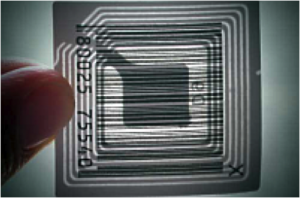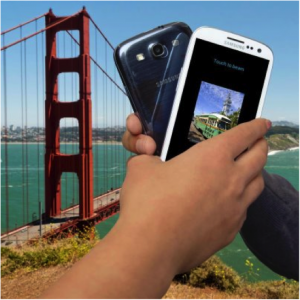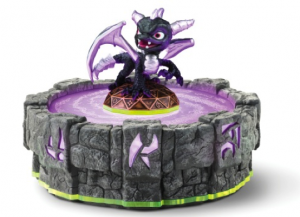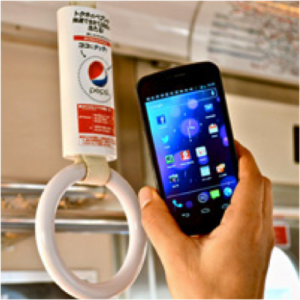by guest blogger Ben Freund
Near Field Communications has been touted as the next big thing to unite print and digital mediums for years now. The technology allows tiny RFID circuits, or “tags,” embedded in physical objects which send data directly to NFC-enabled phones and devices.

Although NFC technology hasn’t taken the world by storm yet, it’s growing faster than ever. In recent months, several organizations around the world have been making breakthroughs in RFID technologies which will allow the tags to be printed using metallic inks. That would allow RFID chips to be produced at a fraction of the cost and time required by current lithographic methods..
Soon, more and more print jobs in fields like advertising and packaging will be making use of this increasingly affordable and effective technology. These recent stories focusing on the growth of NFC in the marketplace offer a glimpse of the future.
Rotten for Apple
 The biggest news for NFC in the past couple of months came with the launch of the iPhone 5, which defied the expectations of many by failing to include NFC technology. That may seem like a major blow to the utility of NFC, but in fact the absence has become a major selling point for Apple’s rivals. Recent advertisements for the Samsung Galaxy feature iPhone fans watching in dismay as Samsung users effortlessly exchange playlists and other data, positioning NFC as a must-have feature.
The biggest news for NFC in the past couple of months came with the launch of the iPhone 5, which defied the expectations of many by failing to include NFC technology. That may seem like a major blow to the utility of NFC, but in fact the absence has become a major selling point for Apple’s rivals. Recent advertisements for the Samsung Galaxy feature iPhone fans watching in dismay as Samsung users effortlessly exchange playlists and other data, positioning NFC as a must-have feature.
Journalists continue to speculate that the iPhone 6 will have NFC compatibility and that Apple’s mobile payment solution, Passbook, is a means for the company to test the willingness of consumers to use their phones as wallets in the coming NFC-enabled marketplace. If true, the combination of support from the two largest phone designers on the planet would make NFC into a true household technology ready for adoption on a massive scale.
Get in the Game
Even if you don’t have a compatible phone, NFC may already have become a household technology for you if you have a video game fan in your house.

NFC made a big splash in the world of gaming last year with the release of a game called Skylanders: Spyro’s Adventure. By using an includedNFC device called the “Portal of Power” players are able to scan special action figures and turn them into playable characters in the game. The addictive thrill of turning physical objects into digital gladiators made the game the third most profitable in North America during the first quarter of 2012, and the accompanying toys outsold even the reigning Star Wars action figure line.
No doubt inspired by that success, Nintendo has included a built-in NFC device in its new Wii U game console, allowing for digital-to-physical interaction. Other consoles from Sony and Microsoft are likely to follow suit, giving NFC more traction.
In fact, Microsoft recently experimented with NFC in an advertising campaign for one of its biggest games this year, and instead of using high tech toys or phone-to-phone communication, it made print the focus of attention.
Transforming Traditional Print
In Sydney, promotional posters for Halo 4 were distributed throughout the city, each equipped with an RFID tag. On the day the game launched, the tags activated and turned the posters in a city-wide scavenger hunt. The first person to scan an ad with their phone was rewarded with a signed copy of the poster. After a winner claimed the poster, the tag went back to directing users to a Halo 4 themed multimedia site, but eager fans could hunt down unclaimed posters using an app supplied by Microsoft.
 And that’s just one of the major print-based campaigns to feature NFC last month. The UK edition of Marie Claire ran England’s first NFC magazine advertisement which allows readers to tap their phones on a page to receive a 2-day gym pass. In Japan, several trains have been plastered with ads for a fiber-infused variety of Pepsi in the form of tagged stickers placed in windows and on handhold straps. Riders who tap the ads with their phones are able to get more information on the product or win free samples by playing simple games.
And that’s just one of the major print-based campaigns to feature NFC last month. The UK edition of Marie Claire ran England’s first NFC magazine advertisement which allows readers to tap their phones on a page to receive a 2-day gym pass. In Japan, several trains have been plastered with ads for a fiber-infused variety of Pepsi in the form of tagged stickers placed in windows and on handhold straps. Riders who tap the ads with their phones are able to get more information on the product or win free samples by playing simple games.
Advertisers are praising NFC in print as a means of allowing potential customers to act immediately when presented with advertisements by making plans or purchases using their phones or other devices. The technology is in place, the public is becoming acclimated to its use, and NFC is spreading rapidly across the media landscape. Expect it to be in demand at print shops soon.
This is a guest post by Ben Freund on behalf of Xcel Products, an industry leading supplier and converter of rigid vinyl and other substrates for packaging and retail advertising solutions.












One Response
Wow, it is crazy to consider the role that technology plays in print communication from one device to another. There seem to be different systems out there that focus on the connectivity of printing apparatus. However, what communication method you get would probably depend on personal need and preference.